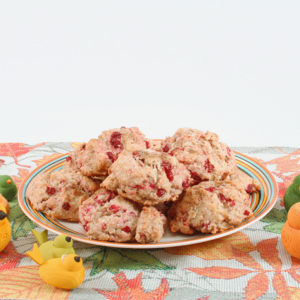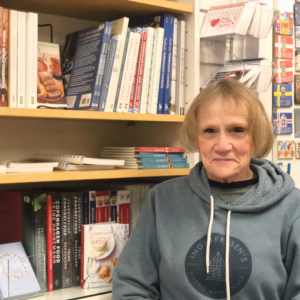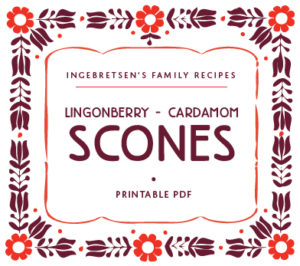
Scones are the quintessential accompaniment to British tea, but they have been popularized worldwide in the last few decades thanks to coffeeshop culture. Now, they have a Nordic flavor, brought to us by Lois Nokleby. Lois is known amongst her Ingebretsen’s co-workers for bringing exceptional baked goods to the store when she works and keeping people happily fed. Her scones are a favorite, made from a recipe she developed herself. “My scone recipe started from a treat someone brought to a meeting in the 80’s. Scones were just making an appearance here in Minnesota at that time. I made the recipe my own first by substituting flavors, then formulas, then incorporating the ingredients and proportions from other similar recipes, like biscuits” says Lois.
The process of developing a recipe takes time and Lois says trial and error is essential. “The squirrels benefit a lot from the things that do not work out,” she says. Her willingness to dive in and create her own recipe started early. “I credit my mother with giving me free rein in the kitchen, so I grew up trying any recipe I found interesting. Beginning in my 4-H years, I have spent a lot of time perusing cookbooks, especially those books that have a story with the recipes,” she says. Lois is currently reading Magnus Nilsson’s The Nordic Cook Book and The Nordic Baking Book. These hefty tomes have the stories that Lois enjoys and Nilsson shares Lois’s philosophy of just diving in and trying something new.

Nilsson writes in The Nordic Cookbook, “Recipes are there to give you a base to start from, inspiration if you will, and also to explain the technical base on which you can build.” Lois encourages people to use her scone recipe as a base, then change the fruit and spices to suit their tastes, and or even their whims.
Lois is a seasoned hand at encouraging people to experiment in realms outside of the kitchen, too. For 35 years, she taught middle school and high school science. Cooking and baking formed the basis for Lois’s interest in science, especially chemistry. Her entire family had a love of cooking and Lois grew up surrounded by grandmothers, aunts, and a mom who baked everything from scratch. “Baking and cooking was part of our family and community culture,” Lois says. She had the benefit of being exposed to three strong baking traditions – Lois’s father’s family was Norwegian and her mother’s, English and German.
Another person who is willing to dive in and make a recipe her own is Ingebretsen’s social media specialist and the photographer for this blog, Autumn Carolynn. Autumn created a gluten- and dairy-free version with almond flour. Her notes on how to make adaptations appear at the end of the recipe below.
Those of us who enjoy BBC programs know that there are two schools of thought on how to pronounce “scone.” Does it rhyme with Joan or with John? Fortunately, the pronunciation is not as fraught with as many class and regional tensions as it once was, so there’s no need to take sides. Whether you bake a scoan or scohn, Lois’s recipe will be thoroughly enjoyable. She does, however, strongly recommend that you serve it with a cup of Viking Biking coffee.
Lingonberry Cardamom Scones
2 c. flour
1 1/2 tsp. baking powder
pinch salt
2 Tbsp. sugar
2 tsp. ground cardamom
1/2 c. butter
3/4 c. fresh or frozen lingonberries
1 egg, beaten
milk and egg to 3/4 cup (Put an egg in a one cup measure. Add milk until you reach the ¾ cup mark.)
1 tsp. vanilla
cardamom sugar
Mix flour, baking powder, salt, sugar, and cardamom in a medium bowl. Cut in the butter. Gently stir in the lingonberries and cover them with flour. Add milk and egg mixture. Stir only enough to mix. Drop by spoon or scoop to cookie sheet. Sprinkle with cardamom sugar. Bake in 350 F oven for 25-30 min.
Cool on a wire rack.
Variations: use fruits, spices, and flavorings as you prefer.
To make this gluten and dairy free, substitute on a 1-to-1 ration: almond flour, almond milk, and dairy-free butter.
